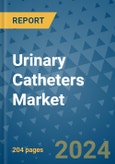Growth Determinants:
1. Ageing Population and Increasing Prevalence of Urinary Disorders: The ageing demographic worldwide is a major driver for the urinary catheters market. As individuals age, they become more susceptible to urinary disorders such as incontinence and retention. With the Global population continuing to age, the prevalence of these conditions is expected to rise, thereby increasing the demand for urinary catheters.2. Advancements in Catheter Technology: Technological advancements in urinary catheters have led to the development of more comfortable, efficient, and safer devices. Innovations such as hydrophilic coatings, antimicrobial materials, and intermittent catheters have improved patient comfort, reduced infection risks, and enhanced overall catheter performance, thereby driving adoption rates among patients and contributing to market expansion.
3. Increasing Surgical Procedures and Hospitalizations: Surgical procedures and hospitalizations often necessitate the use of urinary catheters for managing urinary retention or monitoring urine output. The rising number of surgical interventions and hospital admissions worldwide, driven by factors such as the growing burden of chronic diseases and the expansion of healthcare infrastructure, is expected to boost the demand for urinary catheters in both acute and long-term care settings.
Major Growth Barriers:
1. Potential Risk of Catheter-Associated Urinary Tract Infections (CAUTIs): The risk of CAUTIs poses a significant restraint on market growth. CAUTIs are among the most common healthcare-associated infections, leading to increased morbidity, mortality, and healthcare costs. Efforts to minimize CAUTIs may lead to reduced catheter use or alternative management strategies, limiting market growth.2. Stringent Regulatory Requirements and Compliance Challenges: Regulatory standards governing urinary catheters are becoming increasingly stringent, requiring manufacturers to make substantial investments in research, development, and quality assurance processes. Non-compliance can result in regulatory sanctions and product recalls, impeding market growth and eroding consumer confidence.
3. Availability of Alternative Treatment Options: The availability of alternative treatment options for urinary disorders, such as pharmaceuticals and surgical interventions, presents a challenge to the urinary catheters market. Patients and healthcare providers may opt for non-invasive or less invasive alternatives, limiting the growth potential of urinary catheters.
Key Trends and Opportunities:
1. Technological Advancements: Significant advancements in urinary catheter technology, including antimicrobial coatings and real-time monitoring technologies, are reshaping the market by addressing longstanding challenges and providing innovative solutions for patients and healthcare providers.2. Shift Towards Minimally Invasive Procedures: There is a growing trend towards minimally invasive procedures in urology, driving demand for catheters designed specifically for such procedures. Minimally invasive techniques offer benefits such as reduced patient discomfort and lower risk of complications, contributing to market growth.
3. Focus on Infection Prevention and Catheter-Associated Complications: Addressing infection prevention and reducing catheter-associated complications presents a significant opportunity for market players. Strategies such as developing catheters with enhanced antimicrobial properties and implementing educational programs for healthcare professionals can differentiate products and capture a larger market share.
4. Expansion into Developing Markets: Expanding into emerging markets with unmet needs and growing healthcare infrastructure presents opportunities for market expansion. Companies can leverage their expertise in catheter technology and establish strategic partnerships to capitalize on rising demand in regions such as Asia Pacific, Latin America, and the Middle East.
Regional Analysis:
1. North America: North America leads the market due to its well-established healthcare system and favorable reimbursement policies. The ageing population and high prevalence of urinary disorders contribute to the region's high demand for urinary catheters.2. Europe: Europe prioritizes patient safety, with stringent regulations ensuring high-quality catheters reach the market. The region's awareness of health issues and treatment options translates to a ready market for catheters as a treatment solution.
3. Asia Pacific: The Asia Pacific region benefits from economic growth, leading to increased healthcare spending and acceptance of medical procedures. A cultural shift towards accepting treatments like catheter use for urinary issues further propels market growth in this region.
Competitive Landscape: The urinary catheters market is characterized by intense competition among key players such as B. Braun Melsungen AG, Coloplast A/S, and Becton, Dickinson and Company. These companies focus on product innovation, strategic partnerships, and geographical expansion to enhance their market presence and capitalize on emerging opportunities.
Market Segmentation
By Product
- Intermittent Catheter
- Indwelling (Foley) Catheter
- External Catheter
By Application
- Urinary Incontinence
- Urinary Retention
- Prostate Gland Surgery
- Spinal Cord Injury
- Others
By Region
- North America
- Latin America
- Europe
- East Asia
- South Asia
- Oceania
- Middle East & Africa
This product will be delivered within 1-3 business days.
Table of Contents
Companies Mentioned
- B. Braun Melsungen AG
- Coloplast A/S
- Becton, Dickinson and Company
- Teleflex Incorporation
- Boston Scientific Corporation
- Medtronic plc.
- Hollister Incorporate
- Cook Medical
- Cathetrix
- UroDev Medical
- Stryker Corporation
- Consure Medical
- J and M Urinary Catherters LLC
- Urocare Products Inc.
- Wellspect Healthcare
- CompactCath
- ConvaTec
- Cardinal Health, Inc.
- Amsino International Inc.








